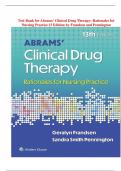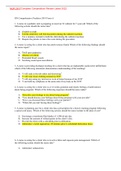Test Bank for Abrams' Clinical Drug Therapy: Rationales for Nursing Practice 13 Edition by Frandsen and Pennington Chapter 1, The Foundation of Pharmacology: Quality and Safety 1. A woman diagnosed with obsessive –compulsive disorder has been prescribed oral paroxetine hydrochloride. What is the expected effect for this prescription? A. Curative effect on symptoms B. Systemic effect on symptoms C. Local effect on symptoms D. Parenteral effect on symptoms CORRECT ANSWER: B Rationale: Medication s that produce systemic effects are taken into the body, circulated through the bloodstream to their sites of action in various body tissues, and eventually eliminated from the body. Curative agents are given to cure a disease process. In this case, paroxetine hydrochloride will control the symptoms but not cure the disorder. Medication s with local effects, such as sunscreen and local anesthetics, act mainly at the site of application. Paroxetine hydrochloride is not administered parenterally. Parenteral agents are administered subcutaneously, intramuscularly, or intravenously. PTS: 1 REF: p. 3, Introduction OBJ: 1 NAT: Patient Needs: Physiological Integrity: Pharmacological and Parent eral Therapies TOP: Chapter: 1: The Foundation of Pharmacology: Quality and Safety KEY: Integrated Process: Nursing Process BLM: Cognitive Level: Understand NOT: Multiple Choice 2. A patient has been prescribed an antibiotic. This medication is a naturally occurring substance that has been cheGmRicAalDlyEmSoBdOifOieSd.TW.ChaOt Mis another name for this type of medication? A. Synthetic medication B. Semisynthetic medication C. Biotechnology medication D. Prototype medication CORRECT ANSWER: B Rationale: Semisynthetic medication s (e.g., many antibiotics) are naturally occurring substances that have been chemically modified. Synthetic medication s are more standardized in their chemical characteristics, more consistent in their effects, and less likely to produce allergic reactions. Biotechnology medication s involve manipulating DNA and RNA and recombining genes into hybrid molecules that can be inserted into living organisms. Prototype medication s are the first medication of a particular group to be develo ped. PTS: 1 REF: p. 3, Medication Sources OBJ: 1 NAT: Patient Needs: Physiological Integrity: Pharmacological and Parenteral Therapies TOP: Chapter: 1: The Foundation of Pharmacology: Quality and Safety KEY: Integrated Process: Nursing Process BLM: Cognitive Level: Understand NOT: Multiple Choice 3. Which classification applies to morphine? A. Central nervous system depressant B. Central nervous system stimulant C. Anti-inflammatory D. Antihypertensive CORRECT ANSWER: A Rationale: Medication s are classified according to their effects on particular body systems, their therapeutic uses, and their chemical characteristics. Morphine is classified as a central nervous system depressant and will produce this effect in the patient . A central nervous system stimulant increases attention and raises mood. An anti-inflammatory agent decreases inflammation at the site of tissue or joint inflammation. An antihypertensive agent reduces blood pressure. PTS: 1 REF: p. 3, Medication Classifications and Protot ypes OBJ: 1 NAT: Patient Needs: Physiological Integrity: Pharmacological and Parenteral Therapies TOP: Chapter: 1: The Foundation of Pharmacology: Quality and Safety KEY: Integrated Process: Nursing Process BLM: Cognitive Level: Remember NOT: Multiple Choice 4. A patient is administered amoxicillin. The generic name of this medication belongs to which medication group? A. Selective serotonin reuptake inhibitors B. Diuretics C. Penicillins D. ACE inhibitors CORRECT ANSWER: C Rationale: The generic namGeRoAfteDnEiSndBicOaOteSs Tth.eCdrOug group (e.g., medication s with generic names ending in “cillin” are penicillins). Selective serotonin reuptake inhibitors are medications that have antidepressant effects; SSRI is a broad classification, not a generic name. Diuretics are medications that increase urine output; diuretic is a broad classification, not a generic name. ACE inhibitor is the broad classification for the angiotensin receptor blockers, not the generic name. PTS: 1 REF: p. 3, Medication Names OBJ: 2 NAT: Patient Needs: Physiological Integrity: Pharmacological and Parenteral Therapies TOP: Chapter: 1: The Foundation of Pharmacology: Quality and Safety KEY: Integrated Process: Nursing Process BLM: Cognitive Level: Understand NOT: Multiple Choice 5. The administration of diphenhydramine is regulated by which U.S. government agency? A. Public Health Service B. Federal Trade Commission C. Occupational Safety and Health Administration D. Food and Medication Administration CORRECT ANSWER: D Rationale: The Food and Medication Administration approves medication s for over -the-
counter availability, including the transfer of medication s from prescription to OTC status, and may require clinical trials to determine the safety and effectiveness of OTC use. The Public Health Service is regulated by the state to maintain the health of individual citizens of the state. The Federal Trade Commission regulates imports and exports throughout the nation. The Occupational Safety and Health Administration regulates safety within the workplace. PTS: 1 REF: p. 4, Prescription and Nonprescription Medication s OBJ: 4 NAT: Patient Needs: Physiological Integrity: Pharmacological and Parenteral Therapies TOP: Chapter: 1: The Foundation of Pharmacology: Quality and Safety KEY: Integrated Process: Nursing Process BLM: Cognitive Level: Understand NOT: Multiple Choice 6. In the U.S., the administration of anabolic steroids is regulated by which law? A. The Food, Medication , and Cosmetic Act of 1938 B. The Comprehensive Medication Abuse Prevention and Control Act C. The Harrison Narcotic Act D. The Sherley Amendment CORRECT ANSWER: B Rationale: The Comprehensive Medication Abuse Prevention and Control Act regulates the manufacture and distribution of narcotics, stimulants, depressants, hallucinogens, and anabolic steroids. The Food, Medication , and Cosmetic Act of 1938 revised and broadened FDA powers and responsibilities, giving the FDA control over medication safety. The Harrison Narcotic Act restricted the importation, manufacture, sale, and use of opium, cocaine, marijuana, and other medication s that the act defiGneRdAaDs EnaSrcBoOtiOcsS. TTh.eCSOhMerley Amendment of 1912 prohibited fraudulent claims of medication effectiveness. PTS: 1 REF: p. 4, Prescription and Nonprescription Medication s OBJ: 3 NAT: Patient Needs: Physiological Integrity: Pharmacological and Parenteral Therapies TOP: Chapter: 1: The Foundation of Pharmacology: Quality and Safety KEY: Integrated Process: Nursing Process BLM: Cognitive Level: Remember NOT: Multiple Choice 7. A nursing practitioner is responsible for maintaining an accurate count and record of the controlled substances on the nursing division. This nursing action is regulated by which U.S. law or agency? A. The Food, Medication , and Cosmetic Act of 1938 B. The Public Health Service C. The Medication Enforcement Administration D. The Sherley Amendment CORRECT ANSWER: C





